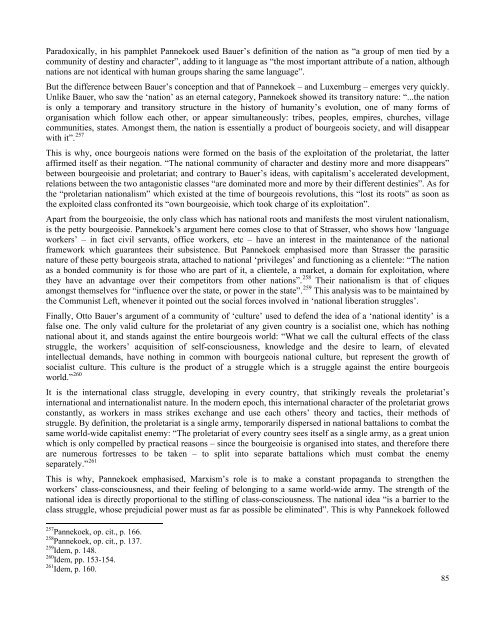The German-Dutch Communist Left - Libcom
The German-Dutch Communist Left - Libcom
The German-Dutch Communist Left - Libcom
You also want an ePaper? Increase the reach of your titles
YUMPU automatically turns print PDFs into web optimized ePapers that Google loves.
Paradoxically, in his pamphlet Pannekoek used Bauer’s definition of the nation as “a group of men tied by a<br />
community of destiny and character”, adding to it language as “the most important attribute of a nation, although<br />
nations are not identical with human groups sharing the same language”.<br />
But the difference between Bauer’s conception and that of Pannekoek – and Luxemburg – emerges very quickly.<br />
Unlike Bauer, who saw the ‘nation’ as an eternal category, Pannekoek showed its transitory nature: “...the nation<br />
is only a temporary and transitory structure in the history of humanity’s evolution, one of many forms of<br />
organisation which follow each other, or appear simultaneously: tribes, peoples, empires, churches, village<br />
communities, states. Amongst them, the nation is essentially a product of bourgeois society, and will disappear<br />
with it”. 257<br />
This is why, once bourgeois nations were formed on the basis of the exploitation of the proletariat, the latter<br />
affirmed itself as their negation. “<strong>The</strong> national community of character and destiny more and more disappears”<br />
between bourgeoisie and proletariat; and contrary to Bauer’s ideas, with capitalism’s accelerated development,<br />
relations between the two antagonistic classes “are dominated more and more by their different destinies”. As for<br />
the “proletarian nationalism” which existed at the time of bourgeois revolutions, this “lost its roots” as soon as<br />
the exploited class confronted its “own bourgeoisie, which took charge of its exploitation”.<br />
Apart from the bourgeoisie, the only class which has national roots and manifests the most virulent nationalism,<br />
is the petty bourgeoisie. Pannekoek’s argument here comes close to that of Strasser, who shows how ‘language<br />
workers’ – in fact civil servants, office workers, etc – have an interest in the maintenance of the national<br />
framework which guarantees their subsistence. But Pannekoek emphasised more than Strasser the parasitic<br />
nature of these petty bourgeois strata, attached to national ‘privileges’ and functioning as a clientele: “<strong>The</strong> nation<br />
as a bonded community is for those who are part of it, a clientele, a market, a domain for exploitation, where<br />
they have an advantage over their competitors from other nations”. 258 <strong>The</strong>ir nationalism is that of cliques<br />
amongst themselves for “influence over the state, or power in the state”. 259 This analysis was to be maintained by<br />
the <strong>Communist</strong> <strong>Left</strong>, whenever it pointed out the social forces involved in ‘national liberation struggles’.<br />
Finally, Otto Bauer’s argument of a community of ‘culture’ used to defend the idea of a ‘national identity’ is a<br />
false one. <strong>The</strong> only valid culture for the proletariat of any given country is a socialist one, which has nothing<br />
national about it, and stands against the entire bourgeois world: “What we call the cultural effects of the class<br />
struggle, the workers’ acquisition of self-consciousness, knowledge and the desire to learn, of elevated<br />
intellectual demands, have nothing in common with bourgeois national culture, but represent the growth of<br />
socialist culture. This culture is the product of a struggle which is a struggle against the entire bourgeois<br />
world.” 260<br />
It is the international class struggle, developing in every country, that strikingly reveals the proletariat’s<br />
international and internationalist nature. In the modern epoch, this international character of the proletariat grows<br />
constantly, as workers in mass strikes exchange and use each others’ theory and tactics, their methods of<br />
struggle. By definition, the proletariat is a single army, temporarily dispersed in national battalions to combat the<br />
same world-wide capitalist enemy: “<strong>The</strong> proletariat of every country sees itself as a single army, as a great union<br />
which is only compelled by practical reasons – since the bourgeoisie is organised into states, and therefore there<br />
are numerous fortresses to be taken – to split into separate battalions which must combat the enemy<br />
separately.” 261<br />
This is why, Pannekoek emphasised, Marxism’s role is to make a constant propaganda to strengthen the<br />
workers’ class-consciousness, and their feeling of belonging to a same world-wide army. <strong>The</strong> strength of the<br />
national idea is directly proportional to the stifling of class-consciousness. <strong>The</strong> national idea “is a barrier to the<br />
class struggle, whose prejudicial power must as far as possible be eliminated”. This is why Pannekoek followed<br />
257 Pannekoek, op. cit., p. 166.<br />
258 Pannekoek, op. cit., p. 137.<br />
259 Idem, p. 148.<br />
260 Idem, pp. 153-154.<br />
261 Idem, p. 160.<br />
85
















